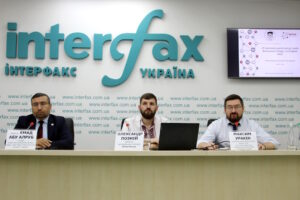
In the Southeast Asian region, Ukrainians have the most positive attitude toward Japan and South Korea. This is evidenced by the results of a joint study by the Experts Club think tank and the Active Group research company, presented at a press conference at Interfax-Ukraine on Thursday.
“Our research has shown that in East Asia, Ukrainians are most supportive of Japan and South Korea. Attitudes toward these countries largely depend on their support for Ukraine after the war began. In the Caucasus region, a positive attitude toward Georgia remains. Also, more than 50% of Ukrainians have a positive attitude towards Kazakhstan. The lowest level of support was recorded for such countries as the DPRK, Syria, and Iraq,” said Oleksandr Poznyi, director of the Active Group research company.

According to the expert, the negative attitude of Ukrainians toward China is also quite eloquent.
“Only 4% of citizens have a positive attitude toward China, 16.7% have a mostly positive attitude, 58.8% have a negative attitude, and 20% have not decided. Currently, China’s position is not entirely unambiguous in relation to Ukraine, which is reflected in the attitude of Ukrainians,” Mr. Poznyi emphasized.
In his turn, Maksym Urakin, founder of the Experts Club think tank and deputy director of the Interfax-Ukraine news agency, presented an analysis of Ukraine’s foreign trade with a number of Asian countries based on data from the State Customs Service for 2023.
“The largest market for Ukrainian goods in Asia is China – more than $2 billion. India ranks second, followed by Kazakhstan, Georgia, Iraq, and Indonesia. As for imports, China is also the largest importer to Ukraine, with more than $10 billion. It is followed by India, Japan, Korea, and Vietnam. In terms of total trade between Ukraine and these countries, China is also the leader, with almost $13 billion. India ranks second – 2.5 billion, followed by Japan – almost a billion,” said Urakin.

According to him, the analysis of economic data shows that Ukraine has significant trade ties with the countries of the Middle East and East Asia. At the same time, China remains one of our country’s largest trading partners in terms of both exports and imports.
“The problem of trade deficit remains, as Ukraine spends a lot of money on imports, while earning little on exports. This is a real problem. In 2023, Ukraine’s trade deficit with all countries is over $27 billion. The deficit with China is $8 billion. Among the countries represented today, we have a positive balance only with Iraq – almost $200 million in favor of Ukraine, Georgia – $100 million, and Armenia – $54 million,” Urakin added.
Chairman of the Ukrainian-Arab Business Council, member of the Council of National Communities of Ukraine Dr. Emad Abu Alrub emphasized that the importance of Ukraine’s relations with the countries of Asia and the Arab world cannot be overestimated, and Ukraine is currently taking important steps to develop these relations.
“Ukraine has significant opportunities in the markets of Arab countries, which have a total population of over 550 million. Arab countries are a permanent market for our goods. After 2014, new markets opened up for our country, especially in Asia. The Ukrainian Arab Business Council is actively working to develop these relations. We need to create a strategic plan to improve relations at the level of economy, politics, and culture. We have significant chances for success, but we need better communication and marketing,” emphasized Dr. Abu Alrub.

He also added that Saudi Arabia is interested in cooperating with Ukraine by investing not only in trade, but also in agriculture, technology, and other projects. Other interesting countries are the UAE, Qatar, and Egypt. All of them also have great potential for investment in Ukraine.
In conclusion, Maksym Urakin called on foreign embassies to be more active in establishing communication with Ukrainian society.
“If you can, please provide information to journalists about what you are doing here, how you are helping in the humanitarian sphere. Through these ties, we will deepen our cooperation, because the way Ukrainian citizens view your countries also depends on your work,” he concluded.
ACTIVE_GROUP, ALEXANDER_POZNYI, EAST_ASIA, ECONOMY, EXPERTS_CLUB, MAXIM_URAKIN, MIDDLE_EAST, SOCIOLOGY, SURVEY
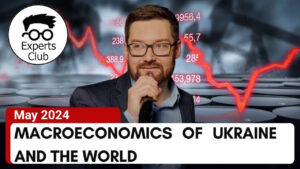
In a new video on its YouTube channel, Kyiv-based think tank Experts Club has presented an analysis of economic trends in the first quarter of 2024 in Ukraine and globally based on official data from the State Statistics Service of Ukraine, the NBU, the UN, the World Bank, and expert forecasts.
Macroeconomic indicators of Ukraine
According to the Center’s founder, Maksym Urakin, in the first quarter of 2024, Ukraine’s GDP grew by 4.1% to 5.3% compared to the same period last year.
“The main growth factors were an increase in agricultural exports and production activity in certain industries. However, the negative balance of foreign trade in goods in the first quarter amounted to almost $6 billion, which is 10% more than last year. This is due to an increase in energy imports after the strikes on the Ukrainian energy sector in March,” Urakin said.
According to the founder of the Experts Club, Ukraine’s national debt has reached a new historical high of $151 billion, which is almost 6 trillion hryvnia in hryvnia equivalent. Inflation in Ukraine in the first quarter was 1% year-on-year, which is in line with the NBU’s target range.
Global economy
Maksym Urakin noted that analysts forecast that the global economy will grow by 2% in 2024, which is lower than expected at the end of last year. The main reasons for the slowdown are high interest rates in developed countries and global geopolitical uncertainty.
“The US economy grew by 1.6% in the first quarter of 2024, which is lower than the growth rate observed in previous quarters, but still at an acceptable level for the development of the country’s economy. China’s economy grew by 5% due to a partial recovery from the crisis and government injections into the technology cluster,” the expert summarized.
He also reminded that the European Commission expects the eurozone economy to grow by only 0.8% in 2024, even less than 1%.
“High inflation and weak domestic demand remain the main problems of the EU countries. However, the British economy showed a modest growth of 0.6%, which indicates a weak recovery after the pandemic and Brexit,” Urakin said.
The economic situation in the world remains tense and depends on many factors, including geopolitical risks and changes in the global economic and political landscape. Experts Club will continue to monitor the situation and provide up-to-date and balanced news.
You can learn more about the macroeconomics of Ukraine and the world in the video by following the link:
Subscribe to the Experts Club channel:
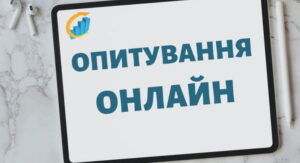
The survey, conducted by Active Group in cooperation with the Experts Club think tank, revealed citizens’ attitudes to various aspects of social and economic life in Ukraine, including the initiative to refund part of the cost of Ukrainian goods, the government’s influence on business, the level of trust in law enforcement, financial stability of citizens, and forecasts for the hryvnia exchange rate.
A significant proportion of respondents (44%) have heard of the initiative to refund the cost of purchasing Ukrainian goods, with opinions divided on its impact on living standards. Most respondents believe that the government will increase taxes to finance this initiative.
According to Andriy Yeremenko, founder of the sociological research company Active Group, this raises concerns among the population, as most are not ready for an increase in the fiscal burden.
The study also revealed a deep distrust of government institutions (57% of citizens) and law enforcement agencies (62%) in the context of relations with business, in particular due to the lack of transparency and efficiency of their work. The majority of respondents believe that the state hinders rather than helps business to develop, and this trend has increased compared to previous months.
A significant number of Ukrainians (up to 60%) are experiencing financial difficulties, including increased debt and lack of savings for a rainy day. Respondents also expressed concern about the future of the hryvnia exchange rate, with the majority (55%) expecting it to fall.
In the context of utility bills, the vast majority (67%) of respondents believe that the level of tariffs is too high, which further emphasizes the general dissatisfaction with the financial situation and government policy in this area.
According to Oleksandr Poznyi, Director of Active Group, these results demonstrate the serious challenges faced by Ukrainian society in the context of the war and the current economic situation.
Earlier, Maksym Urakin, the founder of the Experts Club think tank, noted that in 2024 Ukraine’s public debt may exceed GDP for the first time, which poses significant risks to economic stability in the country.
For more details, please see the video at the link:
https://www.youtube.com/watch?v=8hkvHhyzGLQ
You can subscribe to the Experts Club channel here:
ACTIVE_GROUP, ANDRIY_EREMENKO, ECONOMY, EXPERTS_CLUB, OLEXANDR_POZNYI, POLITICS, SOCIOLOGY, TAXES, URAKIN
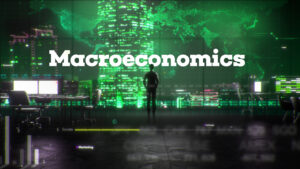
The article collects and analyzes the main macroeconomic indicators of Ukraine. In connection with the entry into force of the Law of Ukraine “On Protection of the Interests of Economic Entities during Martial Law or State of War” the State Statistics Service of Ukraine suspends the publication of statistical information for the period of martial law, as well as for three months from the date of its completion. The exception is the publication of information about the consumer price index, separate information on statistical indicators of 2021 and for the period January-February 2022. The article analyzes open data from the State Statistics Committee, the National Bank and analytical centers.
Maxim Urakin, PhD in Economics, presented an analysis of macroeconomic trends in Ukraine and the world based on official data from the State Statistics Committee of Ukraine, the NBU, the UN, the IMF and the World Bank.
Macroeconomic indicators of Ukraine
Maxim Urakin cited data from the National Bank of Ukraine on the improvement of the financial situation in 2023 compared to 2022.
“Last year was marked by a more favorable macroeconomic environment for the financial industry. GDP growth generally exceeded forecasts and inflation rates declined. Even after the downgrade, the discount rate remains high enough to make hryvnia investments attractive. Thanks to the efforts of the National Bank and market readiness, the transition to a policy of managed flexibility of the hryvnia exchange rate was successful. At the same time, this success was ensured primarily by stable receipts from partners within the framework of macrofinancial assistance and an increase in the share of exports of agricultural products,” Urakin emphasized.
The expert noted that the main risks for the economy remain the duration of the war and instability of international aid.
“In the third quarter of 2023, Ukraine’s GDP growth slowed to 8.2%. The negative balance of foreign trade increased by 3.2 times, which is a worrying signal. Public debt has slightly decreased compared to August figures, but in 2024 it may exceed the country’s GDP for the first time, which poses significant risks to economic stability,” the economist said.
The pace of international aid to Ukraine, in turn, has significantly decreased in the IV quarter of 2023 – I quarter of 2024, which could create significant risks to the country’s economic stability,” the economist said.
I quarter of 2024, which may negatively affect the recovery of the economy in the current year under the conditions of war.
Global Economic Outlook
Maxim Urakin also analyzed the global economy, noting a slowdown in growth to 2.2% in 2024.
“Analyzing the dynamics of global GDP shows that the global economy continues to recover from the pandemic, but geopolitical instability has a restraining effect on this growth. According to Maxim Urakin, it is important to monitor developments and adapt to changing conditions to ensure sustainable economic growth in the future. Ukraine, in this context, needs to focus on strengthening domestic political stability, restoring its economic potential and continuing reforms to improve its post-war prospects and strengthen its position on the global stage,” the expert explained.
According to the expert, the current macroeconomic situation in Ukraine and the world requires further analysis. For Ukraine, the main challenges in the coming years will be the need to rebuild Ukraine after the war and public debt management.
Earlier, the Experts Club analytical center released a video on how the GDP of countries has been changing in recent years, more video analysis is available here.
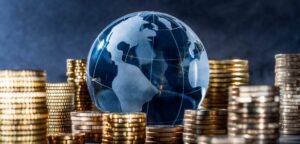
In his analytical video published on the Experts Club YouTube channel, Maxim Urakin, founder of the project and PhD in Economics, focuses on the key indicator of global macroeconomics – gross domestic product (GDP), which plays a central role in analyzing the economic well-being of countries. GDP is the total value of all goods and services produced in a country over a certain period of time. This indicator helps to assess how productive a country’s economy is and is an important indicator of its overall economic well-being.
Analyzing GDP dynamics on a global scale
According to Urakin, analyzing the last decades shows significant changes in the global economy.
“In the 1990s to 2000s, first of all, there was significant economic growth in countries such as the US and China, as well as in developing countries such as India. It was a time of economic prosperity for developed countries and a period of rapid growth for some emerging markets,” explained the founder of Experts Club.
But then the world economy was rocked by crises, including the global financial crisis of 2008 and the subsequent European debt crisis. These events, according to Expert Club, slowed global GDP growth and exposed the vulnerability of many economies previously considered promising.
“In recent years, we have faced new challenges, such as the COVID-19 pandemic, which led to a significant downturn in the global economy, and geopolitical tensions, including the war in Ukraine. These events have re-emphasized the interconnectedness and interdependence in the global economy,” said Urakin.
GDP and geopolitical changes
Urakin notes that in the context of geopolitics, GDP serves not only as a measure of economic development but also as an indicator of international influence.
“India, surpassing the UK, has become the fifth largest economy in the world, which emphasizes the shift of global economic forces to the Asian region. This is also confirmed by the fact that China, having overtaken the US in terms of purchasing power, has confirmed its status as a global economic power,” the economist emphasized.
Future trends
Analysis of global GDP dynamics shows that the global economy continues to recover from the pandemic, but geopolitical instability has a restraining effect on this growth. According to Maxim Urakin, it is important to monitor developments and adapt to changing conditions to ensure sustainable economic growth in the future. Ukraine, in this context, needs to focus on strengthening domestic political stability, restoring economic potential and continuing reforms to improve its post-war prospects and strengthen its position on the global stage.
To learn more about global GDP, check out the video on the Experts Club channel at the link:
You can subscribe to the channel here:
https://www.youtube.com/@ExpertsClub
GDP (Gross Domestic Product) is the total market value of all final goods and services produced in a country over a given period of time (usually a year). It measures a country’s total output and economic activity, being one of the key indicators of its economic health.
Nominal GDP is an estimate of gross domestic product expressed in current market prices, not adjusted for inflation or deflation. This means that when measuring nominal GDP, current prices of goods and services are taken into account, which can lead to higher GDP when prices rise (inflation), even if actual output has not increased.
PPP (Purchasing Power Parity) GDP is a method of estimating GDP that takes into account differences in the cost of living and price level between countries. The PPP GDP calculation uses prices adjusted to reflect real purchasing power in different countries. This allows for a more accurate comparison of living standards and economic activity between countries because it takes into account differences in the cost of goods and services in different places.

On Saturday, March 2, Kyiv will host a training seminar “First Aid for Injuries and Traumas” specially designed for journalists and bloggers. The event is organized by the Experts Club Kyiv Analytical Center with the support of its medical partner, ADONIS Medical Center Group, and its general partner, Pryirpinia Community Foundation.
The training aims to teach participants the basics of first aid in case of injuries and traumas, which is an important knowledge for everyone in times of war.
The seminar will be conducted by an anesthesiologist and co-author of 12 scientific publications, Mariana Bolyuk, who is a representative of the ADONIS Medical Center Group.
ADONIS, EXPERTS_CLUB, FIRST_AID, MEDICAL_AID, MEDICINE, URAKIN, БОЛЮК